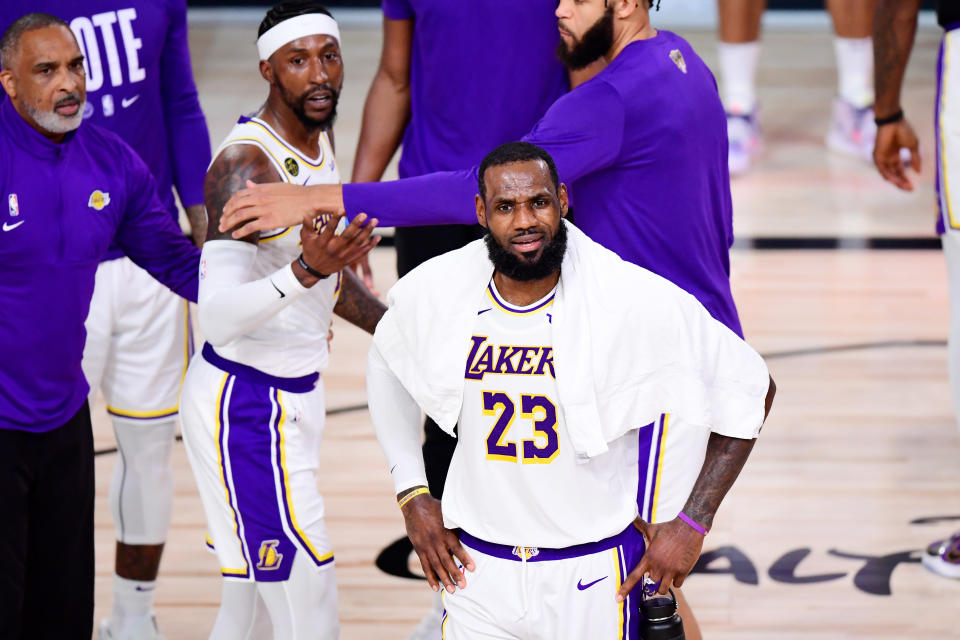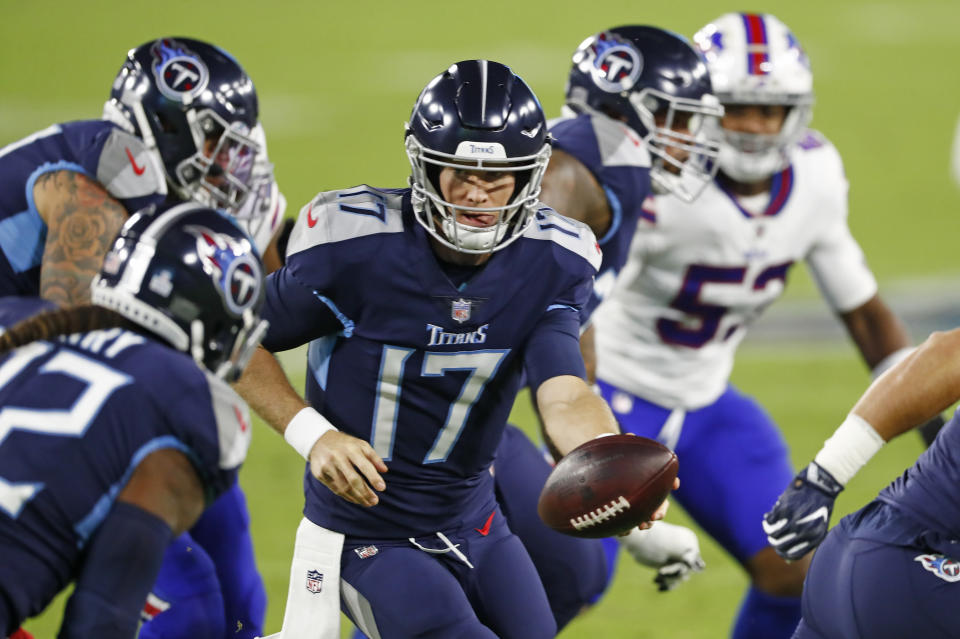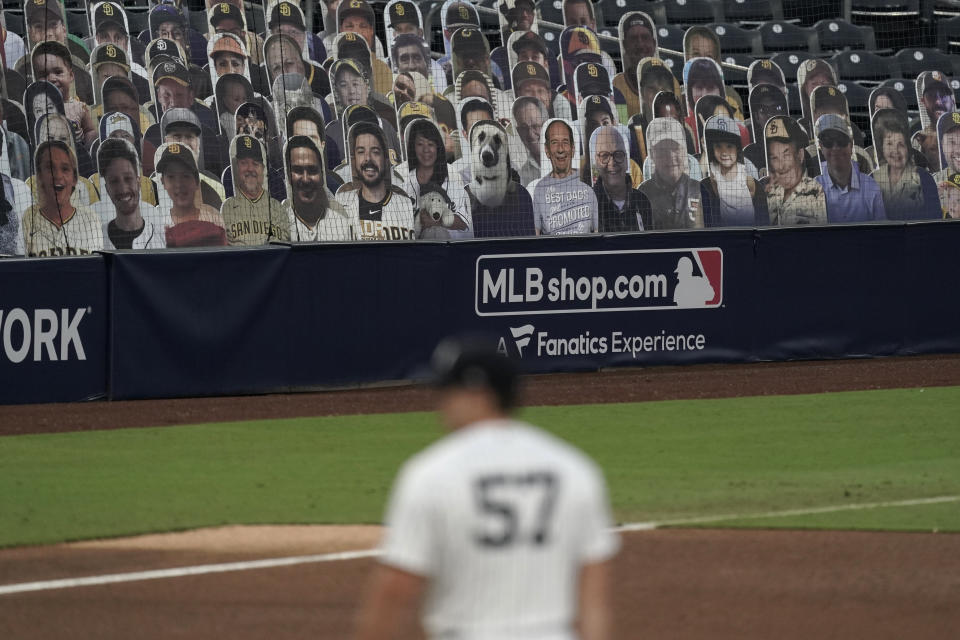Why live sports TV ratings are down for all the big leagues
After the NBA paused its 2020 season on March 11 and the NHL, MLS, NCAA March Madness, and MLB Spring Training all followed suit, American sports fans were left with no live sports to watch for nearly four months.
In June and July, the big leagues all returned to play, creating a crowded fall with the NFL, college football, NHL Stanley Cup Finals, NBA Finals, WNBA Finals, pro golf, and Triple Crown of horse-racing all happening at once. You’d think it would be a sports fan’s dream.
But the eyeballs haven’t returned.
Viewership for all the leagues is down steeply from 2019, according to Nielsen data.
NBA, NFL, NHL, MLB all lower
NBA Finals viewership on ESPN (DIS) averaged 7.45 million viewers per game, down 51% from last year. Game 3 was the lowest-rated NBA Finals Game 3 on record. Heading into the Finals, the Eastern Conference and Western Conference Finals saw a 35% overall decline.
NHL ratings were up 40% when the league first returned to play on Aug. 1, but viewership for the Stanley Cup Finals on NBC (CMCSA) was down 61% from last year.
In baseball, the 2020 ALCS and NLCS were down a combined 30% overall (least-watched ALCS on record), and the World Series on Fox was the least-watched in history, down 32% from the previous low.
Ratings for the Kentucky Derby on NBC, which ran on Sept. 5 (only the second time since 1945 that the race was not held on the first Saturday in May) was down 49% from last year.
Both U.S. Open tournaments were down big: the final round of the U.S. Open golf tournament on NBC, normally played in June, was down 55% from 2019; viewership of the U.S. Open tennis tournament (men’s and women’s) on ESPN was down 50% from 2019.

Even the mighty NFL is seeing a dip: viewership was down 11% through Week 4 of the season.
In NFL Week 5, viewership declined again. Sunday’s late-afternoon national game on CBS (VIAC) between the New York Giants and Dallas Cowboys was off 7% from the equivalent game last year; Fox’s Sunday NFL slate was down 23% from last year’s equivalent window; Sunday Night Football on NBC between the Minnesota Vikings and Seattle Seahawks was down 17% from last year’s equivalent broadcast (but competed with Game 6 of the NBA Finals).
The WNBA was the only exception among the pro leagues: WNBA ratings were up 15% overall, and viewership for Game 3 of the WNBA Finals on ESPN was up 34% over last year.
So: Why are viewers tuning out sports?
First of all, it’s not athlete politics.
While some vocal critics on Twitter (including President Trump, in a tweet about the NBA) have blamed Black Lives Matter and the social justice movement, which the leagues have encouraged (through TV spots and players wearing phrases on the backs of jerseys and helmets).
But the ratings decline is hitting all of the leagues hard (including MLB, which has not embraced the movement on the field nearly as much as the WNBA, NBA, and NFL). And a September Marist Poll of 1,560 American adults found that 46% of those surveyed said the political outspokenness of the athletes has “made no difference in their live TV sports consumption,” Yahoo Sports writes. Another 21% said the political outspokenness has “made them more likely to watch.”
Meanwhile, NASCAR ratings are down just 1% since the start of its season on Feb. 17 with the Daytona 500, suggesting that, contrary to what President Trump claimed in July, the banning of confederate flags from NASCAR events did not turn many fans away.
A glut of live sports
One glaring difference between this fall and last: all the sports are playing at once.
When in the past would you have heard an on-air promo for the NBA Finals during Monday Night Football? The NBA Finals are normally in June. There’s a glut of live sports, causing cannibalization: two of the NBA Finals games were on opposite NFL games. The early ratings success of the NHL Playoffs, which returned on Aug. 1 and enjoyed a few weeks before the crowded fall arrived, backs up the theory that too many live sports at once has hurt ratings for all.
There is no prior comparison for what kind of viewership the NBA and NHL should get in the fall, up against the NFL, since their seasons normally conclude in June. (It’s also worth a mention that the championship matchups were not a network’s dream: Lakers vs Celtics would have likely rated much better for ESPN than Lakers vs Heat, while the NHL matchup of Tampa Bay Lightning vs. Dallas Stars was far from ideal for NBC.)

Election year
2020 is an election year. Live sports viewership in the fall historically takes a hit in election years, while political news networks enjoy a boost. In fact, the current 11% dip for the NFL overall is exactly on par with the dip ESPN saw in the first five weeks of the season in 2016.
In 2016, amid loud media coverage of the NFL ratings decline, the NFL blamed the election in a statement, saying, “The dip in ratings over the first month of the season is likely due to a confluence of factors headlined by the attention around our presidential election, which is unprecedented.”
In an internal memo to the NFL’s media committee, NFL media chief Brian Rolapp elaborated: “The effect of the presidential election on NFL ratings has been seen before: in 2000, during the campaign between George W. Bush and Al Gore, all four NFL broadcast partners suffered year over year declines—Fox was down 4%, CBS was down 10%, ABC was down 7% and ESPN was down 11%.”
And then there’s the global pandemic. On top of following election news, American sports fans have quite a lot weighing on them. The health crisis in America may simply make sports feel less important for many. Given the past election year trend, sports ratings this fall might have dropped anyway, even without the pandemic—but seven months in some form of quarantining and mask-wearing exacerbated the disruption.

No fans in stands
Finally, returning to play during the pandemic, with all the health and safety precautions required, has also changed what the games look like on television.
The NBA showed screens with virtual fans at its games in the bubble; most MLB ballparks put cardboard cutouts of fan photos in their stands; at early NFL games, networks pumped in fake crowd noise. It certainly hasn’t been the viewing experience of the past, and for many fans, it detracted from the appeal. At times, in some sports, the silence has made the game play look less exciting.
The likeliest cause of the ratings dip is a perfect storm of all these external factors: a global pandemic that pushed some viewers away from sports; continuing health and safety measures that changed the way live sports looked once they did return; and an extremely contentious looming election.
For the big broadcasters, there’s a much scarier possibility, beyond 2020: that after four months without sports, many viewers may have discovered they didn’t miss it that much.
And with more content available to them than ever before from streaming platforms like Netflix, Amazon, Hulu, Disney+, and premium cable, those viewers might not return.
—
Daniel Roberts is an editor-at-large at Yahoo Finance and closely covers sports business. Follow him on Twitter at @readDanwrite.
The biggest storyline of the 2020 NFL season isn't the pandemic—it's gambling
Why the sports industry is thirsty for SPACs
Michael Jordan gets equity stake in DraftKings, stock surges
NASCAR's only black driver Bubba Wallace changed the sport forever in 2 days
As live sports return to TV, so do DraftKings and FanDuel ads
DraftKings completes merger to go public, even as sports are shut down

 Yahoo Finance
Yahoo Finance 
